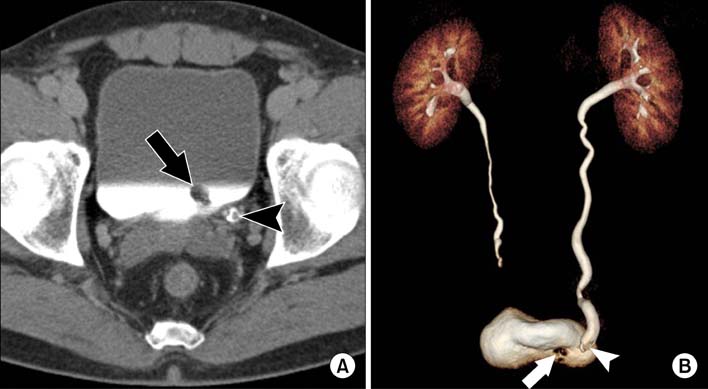Korean J Urol.
2011 Jan;52(1):13-18.
Accuracy and Factors Affecting the Outcome of Multi-Detector Computerized Tomography Urography for Bladder Tumors in the Clinical Setting
- Affiliations
-
- 1Department of Urology, Chonnam National University Medical School, Gwangju, Korea. drjsi@yahoo.co.kr
- 2Department of Diagnostic Radiology, Chonnam National University Medical School, Gwangju, Korea.
- 3Yanbian Tumor Hospital, Jilin, China.
Abstract
- PURPOSE
The objective of this study was to investigate the diagnostic accuracy of multi-detector computerized tomography urography (MDCTU) for the detection of bladder tumors.
MATERIALS AND METHODS
We retrospectively reviewed the medical records of 143 patients who were scanned by use of 64-channel MDCTU and who underwent cystoscopy due to painless hematuria or a clinical suspicion of bladder tumor. We examined the accuracy of MDCTU for the detection of bladder tumors by comparing the results obtained by MDCTU with those obtained by cystoscopy. The associations between tumor characteristics, frequency of transurethral resection (TUR), and bladder volume and detectability of bladder tumors on MDCTU were also analyzed.
RESULTS
Of 143 patients, 50 patients had a history of urothelial carcinomas. In these patients, the sensitivity and specificity of MDCTU were 60.0% and 80.0%, respectively. In 93 patients without previous urothelial carcinomas, the sensitivity and specificity of MDCTU were 86.7% and 96.8%, respectively. Falsely diagnosed cases had a smaller distended bladder volume (p=0.014) and a smaller tumor size (p=0.022) than did true diagnosed cases. The false-negative rate increased when the bladder tumor was located at the bladder neck. In the univariate analysis, the tumor location, size, frequency of TUR, bladder volume, and initial hematuria were associated with detectability by MDCTU (p<0.05).
CONCLUSIONS
To improve the accuracy of MDCTU for diagnosing bladder tumors, bladder filling is recommended. Thus, cystoscopy should be considered as a standard diagnostic tool for bladder tumors even in patients with normal MDCTU results, especially in the evaluation of recurrent, bladder neck-located, small, or sessile bladder tumors.
MeSH Terms
Figure
Reference
-
1. Birnbaum BA, Jacobs JE, Ramchandani P. Multiphasic renal CT: comparison of renal mass enhancement during the corticomedullary and nephrographic phases. Radiology. 1996. 200:753–758.2. Caoili EM, Cohan RH, Korobkin M, Platt JF, Francis IR, Faerber GJ, et al. Urinary tract abnormalities: initial experience with multi-detector row CT urography. Radiology. 2002. 222:353–360.3. Chow LC, Sommer FG. Multidetector CT urography with abdominal compression and three-dimensional reconstruction. AJR Am J Roentgenol. 2001. 177:849–855.4. Griffiths CJ, Murray A, Ramsden PD. Accuracy and repeatability of bladder volume measurement using ultrasonic imaging. J Urol. 1986. 136:808–812.5. Akbar SA, Mortele KJ, Baeyens K, Kekelidze M, Silverman SG. Multidetector CT urography: techniques, clinical applications, and pitfalls. Semin Ultrasound CT MR. 2004. 25:41–54.6. Kim JK, Park SY, Ahn HJ, Kim CS, Cho KS. Bladder cancer: analysis of multi-detector row helical CT enhancement pattern and accuracy in tumor detection and perivesical staging. Radiology. 2004. 231:725–731.7. Sudakoff GS, Dunn DP, Guralnick ML, Hellman RS, Eastwood D, See WA. Multidetector computerized tomography urography as the primary imaging modality for detecting urinary tract neoplasms in patients with asymptomatic hematuria. J Urol. 2008. 179:862–867.8. Chow LC, Kwan SW, Olcott EW, Sommer G. Split-bolus MDCT urography with synchronous nephrographic and excretory phase enhancement. AJR Am J Roentgenol. 2007. 189:314–322.9. Anderson EM, Murphy R, Rennie AT, Cowan NC. Multidetector computed tomography urography (MDCTU) for diagnosing urothelial malignancy. Clin Radiol. 2007. 62:324–332.10. Knox MK, Cowan NC, Rivers-Bowerman MD, Turney BW. Evaluation of multidetector computed tomography urography and ultrasonography for diagnosing bladder cancer. Clin Radiol. 2008. 63:1317–1325.11. Jinzaki M, Tanimoto A, Shinmoto H, Horiguchi Y, Sato K, Kuribayashi S, et al. Detection of bladder tumors with dynamic contrast-enhanced MDCT. AJR Am J Roentgenol. 2007. 188:913–918.12. Shimizu K, Ito K, Matsunaga N, Shimizu A, Kawakami Y. Diagnosis of gastric cancer with MDCT using the water-filling method and multiplanar reconstruction: CT-histologic correlation. AJR Am J Roentgenol. 2005. 185:1152–1158.13. Jung SI, Kang TW, Shin SS, Kwon DD, Park K, Ryu SB. Usefulness of virtual cystoscopy using a 64-channel multidetector-row computed tomography scanner for detecting bladder tumors. Korean J Urol. 2007. 48:383–389.14. Noroozian M, Cohan RH, Caoili EM, Cowan NC, Ellis JH. Multislice CT urography: state of the art. Br J Radiol. 2004. 77:S74–S86.15. Van Der Molen AJ, Cowan NC, Mueller-Lisse UG, Nolte-Ernsting CC, Takahashi S, Cohan RH. CT urography: definition, indications and techniques. A guideline for clinical practice. Eur Radiol. 2008. 18:4–17.16. Kemper J, Regier M, Bansmann PM, Begemann PG, Stork A, Nagel HD, et al. Multidetector CT urography: experimental analysis of radiation dose reduction in an animal model. Eur Radiol. 2007. 17:2318–2324.17. Coppenrath E, Meindl T, Herzog P, Khalil R, Mueller-Lisse U, Krenn L, et al. Dose reduction in multidetector CT of the urinary tract. Studies in a phantom model. Eur Radiol. 2006. 16:1982–1989.
- Full Text Links
- Actions
-
Cited
- CITED
-
- Close
- Share
- Similar articles
-
- Clinical Usefulness of Multi-Detector Computed Tomography in Diagnosis of Patients with Microscopic Hematuria
- The Role of Computed Tomography of the Bladder Cancer with Perivesical Fat Infiltration
- The Value of Excretory Urography in Staging Bladder Cancer
- Computerized tomography in Urology
- Overlooked or unrecognized pitfalls in noninvasive multi-detector computed tomography coronary angiography


